Students get through AP Inter 2nd Year Zoology Important Questions 6th Lesson Genetics which are most likely to be asked in the exam.
AP Inter 2nd Year Zoology Important Questions 6th Lesson Genetics
Very Short Answer Questions
Question 1.
What is pleiotropy? [TS MAY-22]
Answer:
- Plciotropy: The ability of a gene to have multiple phenotypic effects is called pleiotropy.
- Ex: Phenylketonuria (PKU) in humans.
Question 2.
What arc the antigens causing ’ABO’ blood grouping? Where are they present?
Answer:
- The antigens of ABO Blood group system: Antigen A and Antigen B.
- These antigen are present on the plasma membrane of RBC.
![]()
Question 3.
What are the antibodies of ’ABO’ blood grouping? Where are they present?
Answer:
- The antibodies of’ABO’ blood group system:
i) Isoagglutinin A (anti A), ii) Isoagglutinin B (anti B) - These are present in blood plasma.
Question 4.
hat are multiple alleles? [TS MAR – 19]
Answer:
- If a gene has more than two alleles then they are said to be multiple alleles.
- Ex: In humans ABO blood groups are the best example for multiple allelism.
Question 5.
What is erythroblastosis foetalis?
Answer:
- Erythroblastosis foetalsis is an alloimmune condition that develops in an Rh positive foetus whose father is Rh positive and mother is Rh negative.
- In this disorder the antibodies developed against the Rh antigen in mother, cross, placenta and destroy the RBC cells of the Rh -ve foetus during second pregnancy.
Question 6.
A child has blood group ‘O’, if the father has blood group ‘A’ and mother blood group ‘B’, work out the genotypes of the parents and the possible genotypes of the other off spring.
Answer:
- If child’s blood group is ‘O’ then its genotype form is IOIO.
- If father’s blood group is ‘A’ then his genotype form is IAIO.
- If mother’s blood group is ‘B’ then her genotype form is IBIO.
- Possible genotypes of the other off spring are: IAIB, IAIO, IBIO, IOIO.
Question 7.
What is the genetic basis of blood types in ABO system in man?
Answer:
Three alleles sup>A, IB, IO of gene I are responsible for ABO blood grouping.
IAIA / IAIO – for A blood group
IBIB / IBIO – for B blood group
IAIB – for AB blood group
IOIO – for O blood group
Question 8.
What is polygenic inheritance?
Answer:
- Polygenic inheritance is a cumulative effect of two or more genes on a single phenotypic character.
- Ex: Skin colour in humans.
Question 9.
Compare the importance of Y chromosome in human being and Drosophila.
Answer:
- In human beings, the XX chromosomes refer female and XY chromosomes refer male. Hence the Y chromosome determine the sex of the child.
- In Dorsophila, Y chromosome lacks male detenning factors, but contains only genetic information essential to male fertility.
![]()
Question 10.
Distinguish between heterogametic and homogametic sex determination systems.
Answer:
- In hetero gametic beings two different types of gametes are formed.
Ex: XY- in males. - In homogametic individuals only one type of similar gametes are formed.
Ex: XX- in females.
Question 11.
What is hapio-diploidy? [TS MAY-22]
Answer:
- It is a mechanism of sex determination in which the sex of the offspring is determined by the number of sets of chromosomes Ex: Honeybees.
- In honeybees fertilised eggs developed into females and unfertilised eggs developed into male. This means male have half the number of chromosomes ie., haploid and the females have double the number i.e.. diploid hence the name haplo-diploidy.
Question 12.
What are Barr bodies?
Answer:
- Barr body is the inactive X-chromosome in a female somatic cell.
- The extra X-chromosome undergoes heterochromatinisation and becomes inactive during early embryonic development. Human female has one barr body whereas human male has no barr body.
Question 13.
What is Klinefelter’s syndrome?
Answer:
- Klinefelter syndrome is a genetic disorder caused by trisomy (3 chromosomes) in 23 pair.
The genotype is 47XXY. The Klinefelter male has an extra X chromosome. Barr body is present. - The symptoms are hypogonadism, reduced fertility, slight enlargement of breasts.
Question 14.
What is Turner’s syndrome? [TS MAR-19]
Answer:
- Turner’s syndrome is a genetic disorder caused by monosomy in 23rd pair (only one chromosomes). The Karyotype is 45, X. Ban- bodies are absent.
- Symptoms are short stature, gonadial dysgenesis, webbed neck, flat chest with widely spaced nipples.
Question 15.
VVlial is Down syndrome?
Answer:
- Down’s syndrome is a genetic disorder that causes delay in physical and intellectual development.
- It is due to the presence of an additional copy of the chromosome numbered 21 (Trisomy 21).
Question 16.
What is Lyonisation?
Answer:
- It was proposed by Mary Lyon and Liane Russell. Lyonisation is a process by which one of two copies of X-chromosome present in the body cells of female mammals is inactivated.
- The inactive X-chromosome is transcriptionally inactive called heterochromatic body.
Question 17.
What is sex-linked inheritance?
Answer:
The inheritance of a character that is influenced by a gene located on one of the sex chromosomes is called sex-linked inheritance. Ex: Colourblindness, Haemophilia.
Question 18.
Define hemizygous condition.
Answer:
- The condition in which the genes are present on non-homologous portion of either
X-chromosome (or) Y-chromosomes is called hemizygous condition. - For these genes, related alleles ‘are absent on corresponding paired chromosomes.
Ex: X-linked genes and Y-linked genes in males.
Question 19.
What is crisscross inheritance?
Answer:
- Criss-Cross inheritance: It is X linked inheritance where the X linked character present in father is inherited to the daughter. Later this character is inherited to her son.
- The character is passed from father to grand son through the daughter. Similarly linked character present in mother is passed on to grand daughter through son.
Ex: Colour blindness, Haemophilia.
Question 20.
Why arc sex-linked recessive characters more common in the male human beings?
Answer:
- Here 3 sex linked recessive characters are more in males because these genes are located in the X-chromosome.
- Male possess only one X-chromosome an female possess two ‘X’ chromosomes.
So male needs only one copy of the mutant allele to express the phenotype. Two copies of the mutant alleles are needed to express the character in female.
Question 21.
Why are sex-linked dominant characters more common in the female human beings?
Answer:
- In sex-linked dominant inheritance, the gene responsible for genetic disorder is located on the
X-chromosome and only one copy of the allele is sufficient to cause the disorder. - Females are more likely to be affected by sex-linked dominant characters as the females have 2X-chromosomes, they have double chance to inherit the character.
Question 22.
What are sex limited characters?
Answer:
- Sex limited characters are autosomal characters that are limited to only one sex.
- They are due to internal hormonal environment.
Ex: Development of breast in women, beard in man.
![]()
Question 23.
What are sex influenced characters?
Answer:
- Sex influenced characters are autosomal characters that are influenced by sex.
- In sex influenced inheritance, the genes behave differently in the two sexes. Probably because sex hormones provide different cellular environment in males and females.
- Thus heterozygous phenotype may exhibit one phenotype in males and the contrasting one in females.
Ex: Baldness in humans. (Bd condition is non bald in females whereas Bd condition in males is bald)
Question 24.
Mow many base pairs are observed in human genome? What is the average number of base pairs in a human gene?
Answer:
- 3164.7 million nucleotide base pairs were observed in a human genome.
- The average number of base pairs in human gene is 3000.
Question 25.
What is ‘junk DNA’?
Answer:
DNA codes for specific protein. Some DNA is involved in regulating gene expression that codes for specific protein. The remaining DNA is non functional and is called Junk DNA.
Question 26.
What are VNTRs?
Answer:
- VNTRs means Variable Number Tandem Repeats, which are used as genetic markers.
- The VNTRs of two persons show variations. It serves as basis for DNA finger printing.
Question 27.
List out any two applications of DNA fingerprinting technology. [TS MAY-22]
Answer:
Applications of DNA finger printing:
- Forensic analysis
- Medico legal cases
- Pedigree analysis
Question 28.
Define Founder effect. Give one example. [Non-Textual] [TS MAR – 16]
Answer:
- Founder Effect: The loss of genetic variation that occurs when a new population is established
by a very small number of individual from a larger population. - Ex: Population bottlenecks occur when a population’s size is reduced for atleast one generation.
Short Answer Questions)
Question 1.
Briefly mention the contribution of T.H. Morgan to genetics.
Answer:
Contributions of T.H.Morgan: :
- He is the father of Modem Genetics. T.H.Morgan confirmed Mendelian laws of inheritance (chromosomal theory of inheritance)
- Pairs of factors located on chromosomes like beads bear hereditary information. These factor separate segregate into germ cells and recombine during reproduction.
- Certain characters are sex linked because they arise on same chromosome that determines gender.
- Genes which close on chromosomes tend to remain together.
Question 2.
What is pedigree analysis? Suggest bow such an analysis, can be useful.
Answer:
- Pedigree Analysis: All the conclusion regarding gene action have been obtained from controlled crosses. In some situation controlled crosses cannot be performed. E.g: Human
- Scientists have devised Pedigree analysis to study the inheritance of genes in humans.
- Pedigree analysis is useful when studying any population when progeny data from several generation is limited. It is also useful when studying species with long generation time.
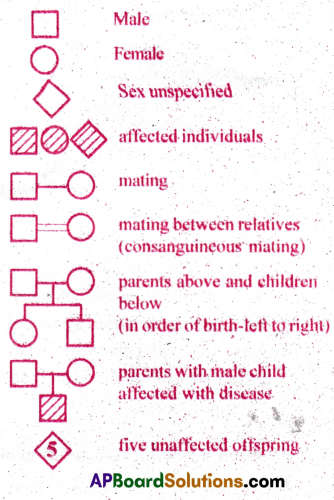
- Once phenotypic data is called from several generations, pedigree is drawn to know the dominant recessive traits.
For dominant gene action:
- affected individuals have atleast one affected parent.
- The phenotype appears in every generation.
- Two unaffected parents have only unaffected children
For recessive gene action:
- unaffected parents can have affected children
- affected children belong to both sexes.
Question 3.
How is sex determined in Human beings? [TS MAY-22] [AP MAR-20] [TS MAR-15]
Answer:
Sex determination in human beings:
- The sex determining mechanism in case of humans is XX-XY type.
- Out of 23 pairs of chromosomes present, 22 pairs are exactly same in both males and females.
- The female’s Karyotype is 44XX; The male’s Karyotype is 44X.Y
- Female produces same type of gametes. Male produces two types of gametes.
- Gametes produced by female are 22X and Gametes produced by male are 22X and 22Y
- When 22X sperm fertilizes 22X ovum, the result is a female child 44XX.
- When 22Y sperm fertilizes 22X ovum, the result is a male child 44XY.
- So, it is clear that, it is the genetic makeup of the sperm that determines the sex of the child.
- It is also clear that in each pregnancy there is always 50 percent probability for either a male or a female child.
![]()
Question 4.
Describe erythroblastosis foetalis. [AP MAY-22] [TS MAR-17] [AP MAR-19,17,16]
Answer:
- Erythroblastosis foetalis( Haemolytic disease) is an alloimmune condition that develops in an Rh positive foetus, whose father is Rh positive and mother is Rh negative.
- The genetic consequence in this marriage is the Rh incompatibility between the mother (Rh-) and the growing foetus(Rh+)
- At the time of delivery, the Rlr blood cells may enter the mother’s blood through ruptured placenta.
- Mother’s immunity system is sensitized and Anti Rh antibodies are produced,
- The first child is safe because delivery is over and antibody formation in mother takes time.
- During the second pregnancy, if the second child is Rh positive, these antibodies cross the placental border and enter the foetal blood circulation. The blood cells of the Rh positive foetus are destroyed causing HDN.
- To compensate loss of cells, foetal hemopoietic system releases erythroblasts (early stage of RBC) into circulation. That is why this disease is called erythroblastosis foetalis.
- Now a days the mother is given anti D (anti Rh anti bodies), when she is pregnant which prevent the formation of antibodies during pregnancy i.e., to prevent sensitization of mother’s immunity system.
Question 5.
Mention any two autosomal genetic disorders with their symptoms.
Answer:
1) Autosomal genetic disorders: Sickle-cell anemia, phenyl ketonuria, thalassemia, cystic fibrosis are Mendelian disorders showing Mendelian type of inheritance. A single mutation in DNA structure causes the disease Down’s syndrome, Edwards syndrome, patau syndrome are also autosomal disorders where chromosomes either added or deleted.
2) Sickle cell anemia: Autosomal genetic blood disorder where R.B.C acquire an abnormal non flexible Sickle shape. They cause inter haemorrhage, physical weakness, organ damage or paralysis,The disease is caused by two allels HbA and HbB on chromosome 11. Heterzygous individual are carriers. It is a case of point mutation where glutamic acid is replaced by valine in 6th position. The heterozygouspeople have an advantage. They are resistant to malaria.
3) Down’s syndrome: An additional chromosome is present in 21st pair. It is a trisomy 21 having 3 chromosomes in the 21st location. The total number of chromosomes will be 46+1 = 47. The condition is designated as (47 +21). The affected individual has a round head, blunt burrowed tongue, physical and mental development is retarded.
Question 6.
Describe the genetic basis of ABO blood grouping.
Answer:
1) ABO Blood Groups: Karl Landsteiner proposed the ABO system of blood groups.
2) Genetic basis of ABO Blood group is mainly dependent on 3 alleles IA, IB and IO (or i) of the gene I located on chromosome 9 was discovered by Bernstein.
3) Alleles IA and IB produce antigen A and antigen B respectively.
4) Allele IO does not produce any antibodies.
5) Allele IA and IB are dominant over IO but codominant to each other
6) A child receives one of the three alleles from each parent, giving rise to six possible genotypes and four possible blood types.
7) The 6 genotypes are as follows:
- IAIA
- IAIO
- IBIB
- IBIO
- IAIB
- IOIO
8) The four Phenotypes are as follows:
- IAIA and IAIO are A group blood
- IBIB and IBIO are B group blood
- IAIB are AB group blood
- IOIO are O group blood
Question 7.
Describe male heterogamety.
Answer:
Male heterogamety: In this type of sex determination males produce two types of gametes and females produce only one type of gametes. There are two kinds. XX-XO and XX-XY.
1) XX-XO type: It is found in bugs, grasshoppers and cockroaches.
The females are AAXX and produce only one type of gametes (AX).
The males are AAXO and produce two types of gametes.

The sex is determined by the sperm that fertilizes.
2) XX-XY type: In this type of sex determination. The female genotype is AAXX and male is AAXY.
Female produces only AX gametes and male produces AX and AY gametes in equal number.
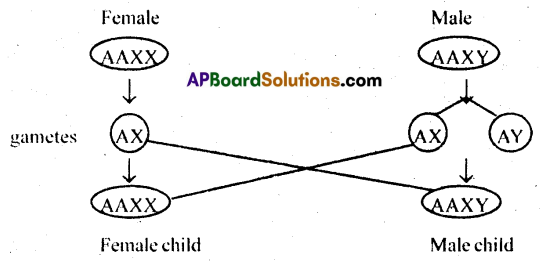
The sex of the offspring is decided by the sperm that fertilizing ovum.
It is found in humans and Drosophila.
Question 8.
Describe female heterogamety.
Answer:
Female hetero gamely: In this type of sex determination females produce two types of gametes
and males produce only one type of gametes.
There are two kinds. ZO–ZZ type and ZW-ZZ type.
1) ZO-ZZ type: It is found in Fumea (moth) and some butterflies.
Male produces only AZ gametes Female produces AZ and AO types of ova.
The sex is determined by the ovum that is fertilized.

2) ZW-ZZ type: It is found in some fishes, reptiles and birds. The female produces two types of ova AZ and AW.
Male produces only one type of sperms AZ.
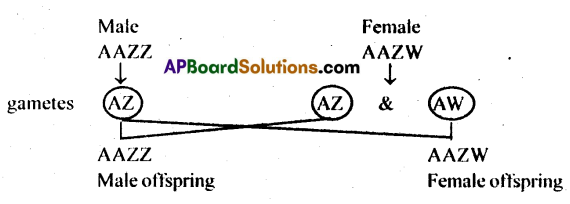
The sex of the offspring is decided by the sperm that fertilizing ovum.
It is found in humans and Drosophila.
![]()
Question 9.
Describe the Genic Balance Theory of sex determination.!AP MAY-22UAP MAR-15|
Answer:
- Genic balance mechanism of determiantion of sex was first observed and studied by C.B.Bridges.
- He found that in Drosophila ‘Y’ chromosome is not necessary for male character.
- The ratio between number of X chromosomes and number of haploid sets of autosomes determines the sex.

- Bridges crossed a triploid female (AAA XXX) to a normal male (AAXY) and observed many different karyotypes in the offspring.
- Ratio of X chromosomes to autosomes in Drosphila melanogaster as follows:
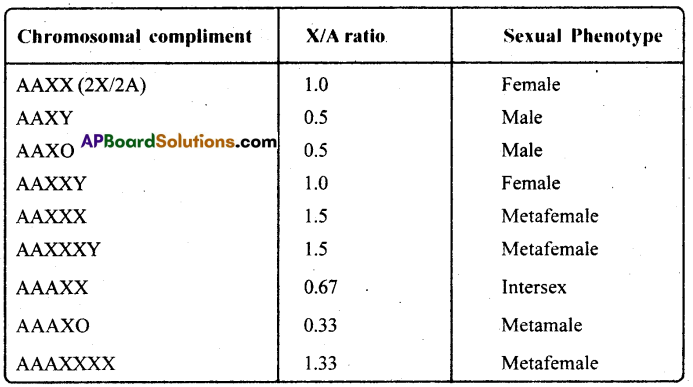
Question 10.
Explain the inheritance of sex linked recessive character in human being.
Answer:
1) Inheritance of sex linked recessive character: The most common X linked recessive disorders are colour blindness hemophilia and duchenne muscular dystrophy.
2) Colour blindness: The genes controlling colours blindness are present on the X chromosomes.
3) The dominant gene influences normal vision.
The recessive gene causes colour blindness.
4) In males there is only one X chromosome (hemizygous). Any gene present on X or Y, it will be expressed. So males are more prone to recessive disease (X linked).
5) In females there are two X chromosomes and colour blindness occurs when she is homogygous (Xcb) for the character.
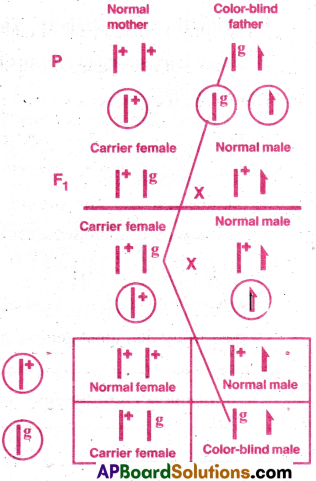
6) In homogygous dominant (XCXC) and heterozygous (XCXcb) condition she will have normal vision because of Xc dominant gene.
7) But in heterozyous XCXcb she is carrier.
8) When both the parents have normal vision all the children will have normal vision.
9) The inheritance is a criss-cross inheritance and the disorder from the male parent passes to the grand son through carrier daughter.
10) When the mother is colour blind and father has normal vision, all the sons will be colour blind and all the daughter will be carriers.
11) When mother has normal vision (homozygous) and father is colour blind all the sons and daughter will have normal vision but girls will be carriers.
Question 11.
Describe the experiment conducted by Morgan to explain sex linkage.
Answer:
- Morgan’s experiment: T.H.Morgan discovered sex linkage in Drosophila.
- He crossed a white eyed male with normal red eyed female.
- In the F1 generation all the males and females were red eyed. Fj red eyed female was crossed to a red eyed male.
- In F2 generation all the female have red eyes and 50% males got white eyes and remaining red eyes.
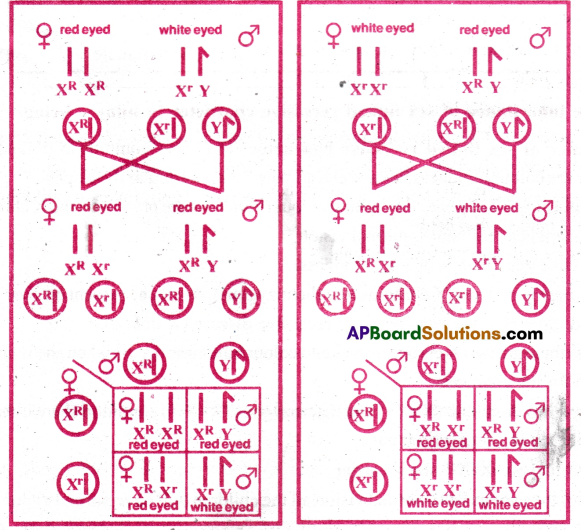
- The white eye character of male parent is inherited to F2 male through F1 carrier female.
- The type of inheritance is called criss-cross inheritance or skip generation inheritance.
- In a reciprocal cross a white eyed female is crossed with red eyed male.
- In F1 generation all the females were red eyes and all the males were white eyed.
- Males inherit X linked character from the female parent.
- White colour is X linked and males express it even with a single gene. In female the white is possible only in homozygous recessive condition.
- So the recessive X linked is more readily expressed in male because only one X chromosome.
- In female it is rarely expressed because female has two X chromosome and there is always a possibility dominant gene in one of the two chromosomes.
- It is evident from his experiments that a specific gene is associated a specific chromosome.
![]()
Question 12.
Explain the inheritance of sex influenced characters in human beings.
Answer:
1) Sex influenced characters: Sex influenced genes are called autosomal genes.
2) These genes are present in both sexes, but expressed in one sex only.
3) They behave differently in tw o sexes. The expression of these genes is influenced by sex hormones. Eg: Baldness in human being, horns in sheep.
4) Baldness: Baldness is caused by a dominant gene B Normal thick hair is due to recessive gene b.
(i) When dominant gene for Baldness is in homozygous condition (BB).
(a) Males are completely bald
(b) Females are sparsely haired.
(ii) When the genes are in heterozygous condition (Bb).
(a) males are bald
(b) females have normal hair.
(iii) When the genes are in recessive homozygous (bb) both males and females have normal hair. The gene expression is complete in males and influenced by hormones in female. When a heterozygous normal haired female marries a bald hetero zygous male the children will be
(a) males – 3 bald : 1 non bald
(b) females – 1 sparsely haired : 3 normal.
Question 13.
A man and woman of normal vision have one son and one daughter. Son is colour – blind and his son is with normal vision. Daughter is with normal vision, but one of her sons is colour – blind and the other is normal. What are the genotypes of the father, mother, son and daughter?
Answer:
- Colour blindness causing gene is X linked gene. This character exhibits criss cross inheritance.
- Because the son is colour blind, he received the gene from her mother.
- The mother has normal vision. So she is heterozygous to the colour blind gene. AA XCXcb (C-normal vision, Cb-colour blind)
- The father has normal vision. Male have only one X chromosome (hemizygous).
- He will have only one gene. It will express phenotypically.
- He has dominant gene for normal vision. His genotype is AAXCY.
- The son is colour blind. His genotype is AAXcbY,
- The daughter has normal vision blit one of her sons is colour blind. So she is heterozygous. Her genotype is AACXcb.
Father AAXCY; Mother AAXCXcb.
Son AAXcbY; Daughter AAXCXcb.
Question 14.
A colour – blind man married a woman w ho is the daughter of a colour – blind father and mother homozygous normal vision. What is the probability of their daughters being colour-blind? [TSMAY-17]
Answer:
- As the female father is colour blind and mother is homozygous normal vision, so woman will be carrier with normal vision.
- Genotype of colour blind man is XcbY
- Genotype of female is XCXcb
- Cross between these two =XcbY x XC– Xcb
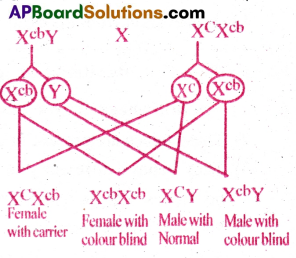
The probability of their daughters:
- 50% Daughters with colour blind Xcb
- 50% Daughters normal vision but carriers XCXcb 50% of daughters will be colour blind and other 50% are with normal carrier
Question 15.
A heterozygous bald man who is non – haemophilic, married a woman who is homozygous for the non – bald trait and is haemophilic. What is the probability of her male children becoming bald and haemophilic?
Answer:
- Heterozygous bald person and non haemophilic. His genotype ABAbXHY.
Genes for baldness are autosomal and haemophilic gene is X linked recessive. - Woman is homozygous for non bald and is haemophilic.
Her genotype is AbAbyhXh. - Non bald gene is recessive. Haemophilia in woman is expressed when the gene is present on both X chromosomes (homozygous)
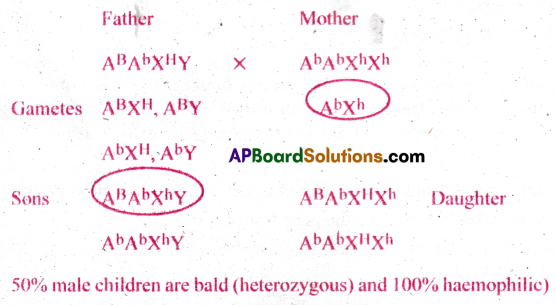
Question 16.
A woman’s father shows ‘IP’ hut her mother anti husband are normally pigmented. What will be the phenoty pic ratio of the children?
Answer:
- The gene for incontinentia pigmenti(ip) is a dominant X linked gene.
- Skin look patchy due to loss of pigment and women are more prone to the disease because there are two X chromosomes and possibility of having a dominant is great.
- Wife’s father has IP. His genotype is AAXIPY.
- Wife’s mother is normally pigmented. Her genotype is AAXX
- So Wife’s genotype is AAXIPX because she gets one X chromosome from father and one from mother (she is heterozygous for the IP gene)
- Husband is normally pigmented. His genotype is AAXY.

![]()
Question 17.
Write the salient features of ‘HOP’.
Answer:
Salient features of Human Ccnoinc Project:
- The average gene has 3000 bases with different sizes. The large gene codes for protein dystrophin.
- The total number of genes estimated is 30,000. 99.9% nucleotide base pairs are exactly same in all people.
- The function is not known for 50% of genes discovered.
- Less than 2% of genome codes for protein.
- A large part of genome consists of repeated sequences.
- The repeated sequence are thought to have no direct coding function. They may shed light on chromosome structure dynamics and evolution.
- Chromosome I has highest number of genes (2968) Y-chromosome has fewgenes(231).
- There are 1.4 million locations where single base differences (SNPs) occur in humans. This information helps to know the disease associated sequences and tracing human history.
Question 18.
Describe the steps involved in DNA fingerprinting technology.
Answer:
DNA Finger Printing: DNA finger printing has the following steps.
- Obtaining DNA: DNA is procured from blood, saliva, hair roots, semen etc., copies of DNA can be produced by cloning and DNA amplification.
- Fragmenting DNA: With the help of restriction endonucleases DNA is cut into smaller fragments at specific sites.
- Separation of DNA fragments by electrophoresis: DNA fragments are applied at one end of agarose gel plate. Electric current is applied to get. DNA fragments travel across the gel, smaller pieces travel farther.
- Denaturing DNA: By using alkaline chemicals the two strands of DNA are separated (or by heating).
- Blotting: A thin nylon membrane is placed over DNA fragments (plate) and covered by paper towel. Towel absorbs moisture. DNA strands are transferred to nylon membrane. This process is called Southern blotting after the name of its inventor E.M.Southem.
- Using probes to identify specific DNA: Radioactive probes are used. The probe is a complementary single strand of the sample under study. The probe is attached sample strand pairing by hydrogen bonds.
- Hybridisation with probe: After the probe hybridises and excess probe is washed off. A photographic film is placed on the membrane containing DNA hybrids.
- Exposure on film to make a DNA Finger Print: The radioactive label exposes the film to form an image corresponding to specific DNA bands. The thick and thin bands form a pattern which is called DNA finger print.
Long Answer Questions
Question 1.
What are multiple alleles? Describe multiple alleles with the help of ABO blood groups. [AP,TS MAY-22] [AP MAR-16,20]
Answer:
I) Multiple alleles: Generally a gene has two alleles, one dominant and other recessive.
Sometimes a gene may have more than two alleles. Such alleles called multiple alleles which exist in a population of specific organism.
The number of Genotypes for multiple alleles can be known by the formula n(n+1 )/2, where n is the number alleles.
A best example for multiple alleles is ABO blood groups. There are three alleles for a single gene.
II) ABO Blood Groups:
The four Blood groups A, B, AB and O types are characterized by the presence or absence of antigens on the plasma membrane of RBCs.
The Antigens are sugar polymers. These are bound to lipid molecules.
They are also called isoagglutinogens because they clot during incompatible blood transfusions. Blood type A persons have antigen’A’ on their RBCs and anti-B antibodies in the plasma. Blood type B persons have antigen ‘B’ on their RBCs and anti-A antibodies in the plasma. Blood type AB persons have antigens ‘A’ and ‘B’ on the RBCs and ‘no anti-A and anti-B antibodies’in the plasma.
Blood type O persons have ‘no antigens’ on their RBCs and both ‘anti-A’ and ‘anti-B’ antibodies in the plasma
III) Genetic basis:
1) Karl Land Steiner proposed the ABO system of blood groups.
2) Genetic basis of ABO Blood group is mainly dependent on 3 alleles IA, IB and IO (or i) of the gene I located on chromosome 9.
3) Alleles IA and IB produce antigen A and antigen B respectively.
4) Allele IO does not produce any antigens.
5) Allele IA and IB are dominant over IO but codominant to each other
6) A child receives one of the three alleles from each parent, giving rise to six possible genotypes
7) The 6 genotypes are as follows:
- IAIA
- IAIO
- IBIB
- IBIO
- IAIB
- IOIO
8) The four Phenotypes are as follows:
- IAIA and IAIO are A group blood
- IAIB are AB group blood
- IBIB and IBIO are B group blood
- IOIO are O group blood and four possible blood types.
IV) Compatibility:
- A+ group can receive blood from A+, A– and O– groups.
- A– group can receive blood from A– and O– groups.
- B+ group can receive blood from B+, B– and O– group.
- B– group can receive blood from B– and O– groups.
- AB+ can receive from all other groups. Hence AB+ is called universal recepient. AB– can receive from A–, B–, AB– and O– groups.
- O+ can receive blood only from O+ and O– groups.
- O+ can receive blood only from O+ but not from any other group.
- O– can be transfused to any other group. Hence O– is called universal donor.
![]()
Question 2.
Describe chromosomal theory of sex determination. [AP TS MAR-19] [TS MAR, MAY-17]
Answer:
Chromosomal theory of Sex determination:
In most of the animals, a pair of chromosomes are responsible for the determination of sex. These two chromosomes are called sex chromosomes or allosomes.
The two different chromosomes in the pair are X-chromosome & Y- chromosome There are two types of sex chromosomal mechanism methods:
I) Male Heterogametie method
II) Female Heterogametic method
I) Male Heterogametic method: In this type, the female has two ‘X’ chromosomes and the male has only a single ‘X’ chromosome.
This is of two types: (1) XX-XO (2) XX-XY
1) XX-XO type:
- It is found in bugs, grasshoppers and cockroaches.
- Females have two X chromosomes and males have only one X chromosome.
- Unpaired X chromosome determines the male sex.
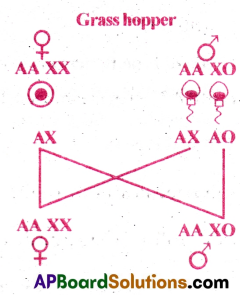
- Karyotype of female is AAXX and Karyotype of male is AAXO.
- All the ova contains (AX) chromosomes.
- The sperms are two types. 50% of sperms have AX complement and other 50% have only A complement.
- The sex of the offspring is decided by the sperm that fertilizes the ovum.
2) XX-XY type:
- It is found in human beings and Drosophila.
- Female is homogametic with Karyo type AAXX and produces ova having AX complement.
- Male is hetero gametic with Karyotype AAXY
- 50% of sperms are AX and other 50% are AY.
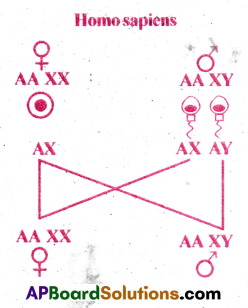
- The sex of the offspring is determined by the sperm that fertilizes the ovum.
- If AX sperm is fertilized the child will be female (AAXX)
- If AY sperm is fertilized the child will be male (AAXY)
II) Female heterogametic Method: In this type, female produces two types of ova and male produces only one type of sperms.
This of two types.
- ZO-ZZ type and
- ZW-ZZ type.
1) ZO-ZZ type:
- It is found in Fumea (moths) and some butterflies.
- Female is heterogametic with one Z chromosomes.
- Male is homogametic with two Z chromosomes.

- Karyo type of female is AAZO and Karyo type of male is AAZZ
- The sex of the offspring is determined by the ovum that is fertilized.
- If AO ovum is fertilized, it will be female.
- If AZ ovum is fertilized, the offspring will be male.
2) ZW-ZZ type:
- It is found in birds, reptiles and some fishes.
- Female is heterogametic with Z and W chromosomes.
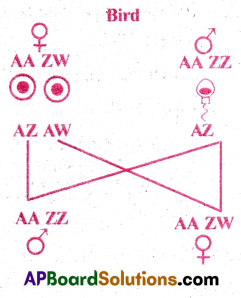
- Male is homogametic with ZZ chromosomes.
- Karyo type of female is AAZW and Karyo type of male is AAZZ.
- The sex of the offspring is determined by the ovum that is fertilized.
![]()
Question 3.
What is crisscross inheritance? Explain the inheritance of one sex linked recessive character in human beings. [TS MAR-16,15] [AP MAR-19,17,15]
Answer:
Criss Cross inheritance: T.H. Morgan observed sex linked inheritance in Drosophila.
The X-linked recessive character present in a man is inherited to his grandson through his daughter. This type of inheritance is called criss-cross inheritance or skip generation inheritance.
Two best examples of criss-cross inheritance are Colour blindness and Haemophilia.
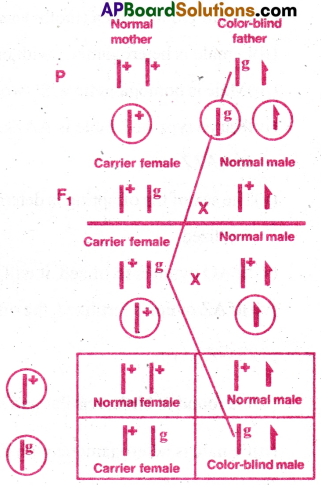
Explanation: Normal Color-blind
- Every gene whether dominant or recessive is expressed phenotypically.
- Males have only one X chromosome.
- Males are more prone to X-linked recessive gene expression.
- Females have two X chromosome. There are more than 50% of chances of having a dominant gene.
So females are less prone to X-linked recessive gene expression.
Colour Blindness:
- The retina of eye is made up of rods and cone cells.
- The cone cells are responsible for colour vision.
- A recessive gene present on X chromosome causes colour blindness (Red-green).
- The dominant gene influences normal colour vision.
- When a woman (AAXCXC) with normal vision marries a ‘colour- blind’ man (AAXcbY), all the daughter will be the earners. Their Karyotype is (AAXCXcb) with normal vision. Hence all the sons have normal vision. Their Karyotype is (AAXCY).
- When the carrier daughter marries a man with normal colour vision, 50% of sons gets colour blindness. All others will have normal vision, of which 50% of daughters are carriers. Here the colour blind character of the parent is inherted by grandson through the carrier daughter.
Other possible inheritances:
- When both parents are colour blind all their children will be colour blind.
- When mother is colour blind and father has normal vision, all their sons inherit colour blindness from mother. All the daughter will be carriers because they get a dominant gene from father and recessive gene from mother.
- When mother is a carrier and father is colour blind, 50% of daughters and 50% of sons get colourblindness.
So, the X-linked characters are inherited by daughters from father, by sons from their mother.
Question 4.
Write an essay on common genetic disorders.
Answer:
Common genetic disorders: A number of disorders in human being are associated with gents or chromosomes. They are divided into two categories.
- Mendelian disorders.
- Chromosomal disorders.
1) Mendelian disorders: These disorders exhibit Mendilian type of inheritance. They are caused by single mutation in DNA and hence called monogenic diseases. They may be autosomal or sex linked.
Ex: Haemophilia, sickle cell anemia, Phenyl Ketonuria, colour blindness, Thalassemia, cystic fibrosis, DMD and albinism.
1) Haemophilia: It is a bleeder’s disease. Blood doesn’t clot easily when a wound occurs accidentally.
Haemophilia A is due to deficiency of clotting factor VIII.
Haemophilia B is due to deficiency of clotting factor IX.
H-A and H-B are X linked recessive disorders.
Haemophilia C is an autosomal recessive disorder due to deficiency of blood clotting factor XI. A&B follow skip generation inheritance. Haemophilia is dangerous to women and rarely occur in them because it needs two recessive genes in females. It is common in men.
2) Sickle cell anaemia: It is an autosomal recessive disorder caused by a defective gene on chromosome 11. It is expressed in homogygous condition. The symptoms are physical weakiness, pain, organ damage due to internal bleeding and even paralysis. It is caused by replacement of glutamic acid in the sixth position, by valine. The RBC become sickle shaped and rigid. They cut the capillary wall when passing through them. Heterozygous individuals also some times feel the symptoms of the disease. But they are less prone to malaria.
3) Phenyl Ketonuria: It was discovered by A.Folling. It is autosomal recessive metabolic disorder due to the gene located on 12th chromosome. The patient cannot-produce phenyl alanine hydroxylase which converts phenyl alanine into tyrosine. Due to lack of the enzyme, phenylalanine is converted to phenyl pyruviate. Accumulation of phenyl ketone cause mental retardation.
4) Colour blindness: It is sex linked recessive disorder. Protanopia is red colour blindness and deuteronopia is green colour blindness. They cannot distinguish between Red and Green colour. Ishihara colour test is conducted to diagnose the diseasie.Tritanopia is an autosomal disorder called blue colour blindness.
5) Thalassemia: It is a autosomal recessive disorder. The haemoglobin is affected. The gene that affects a-chains is on chromosome 16. The gene that affects (3-chains is on chromosome 11. They damage the plasma membrane of RBC there by the number of RBC is reduced and destroyed. The patient becomes anaemic.
6) Cystic fibrosis: It is autosomal recessive disorder. The affected gene is present on the long arm chromosome of 7 that influences salt and water movement!
Symptoms:
- Increased sodium and chloride in sweat.
- The mucus become viscous and sticky
- Mucus builds up in the organs of lungs, pancreas, alimentary canal etc.,
- The patient may die before reaching age of five iff untreated.
![]()
II) Chromosomal disorders:
These disorders are caused either by addition or deletion of a chromosome or accidental exchange of chromosomal bits during meiosis and non disjucntion.
When a chromosome is deleted from a pair, it is monosomy.
When a chromosome is added to a pair, it is trisomy.
Examples of Chromosomal disorders:
1) Klinefelter syndrome: It is trisomy in 23rd pair in males. It is written as 47, XXY. Symptoms: Hypogonadism and reduced fertility. Slight enlargement of the breasts (gynecomastia)
2) Turner’s Syndrome: It is monsomy in 23rd pair in females. It is written as 45, X Symptoms: Flat chest, short statue, webbed neck and lack of Barr bodies.
3) Down Syndrome: It is trisomy in 21 pair.
Symptoms: Delay in physical and mental development. Small, round head, burrowed blunt tongue, open mouth.
4) Edwards syndrome: It is trisomy in 18th pair. It is more common in females.
Symptoms: Cardiac abnormalities, kidney mal function.
Generally the child dies in foetal stage or in early years of life.
5) Patau syndrome: It is trisomy in 13th pair.
Symptoms: Heart and kidney defects; Brain and spinal cord abnormalities, poorly developed eyes. Effected child dies within few weeks after birth.
6) Cri-du-chat syndrome: It is due to partial deletion of short arm of chromosome 5. Symptoms: Cat like cry, mental retardation, small head, unusual facial features.
Effected child dies in infancy or childhood.
7) Chronic Myelogenous Leukemia (CML) (46,9:22): A piece of 9th chromosome and a piece 22nd chromosome switch places.
Symptoms: cancer (Leukemia) in addition to other abnormalities.
Question 5.
Why is the Human Genome project called a mega project?
Answer:
1) Human genome project: A genome is a complete set of DNA molecules present in all the chromosomes of an individual put together.
2) The structural development of a person is influenced by his DNA complement. If two persons
look different it is because their DNA is different. This assumption paved way for finding out complete, DNA sequence of human DNA.
3) Human gettome project was started in 1990 and took 13 years for completion.
The project was supported U.S dept of energy, National Institute of health, welcome trust and many other countries because it was a mega project. Along with human genome sequencing, non human genome sequences were also studied. They helped the progress of HGP.
4) Goals of HGP:
- To identify all the 30,000 genes in human DNA
- To determine the sequences of 3 billion base pairs of human DNA
- To improve tools for data analysis.
- To resolve the ethical, legal and social issues that may arise from HGP.
5) Methodologies: There are two major approaches.
- To identify all the genes that expressed as RNA [expressed sequence tags] ESTs
- To sequence the whole set of genome continuing coding and non coding sequences later assigning with function (sequence annotation)
6) DNA sequencing: It is the process to determine the exact order of the 3 billion base pairs.
- The total DNA from a cell is isolated and converted into random fragments and cloned in suitable host (bacterian and yeast)
- The fragments are sequenced using automated DNA sequences developed by Frederick Sanger.
- The sequences were assigned the corresponding chromosome through specialized computer programs.
- Latest method of sequencing is shot gun sequencing using super computers.
7) Salient features of HCiP: The salient features of human genome project are
- The human genome consists of chromosomes which are made up of three billion nucleotide pairs.
- The average gene has 3000 bases with different sizes. The large gene codes for protein dystrophin.
- The total number of genes estimated is 30,000.99.9% nucleotide base pairs are exactly same in all people.
- The function is not known for 50% of genes discovered.
- Less than 2% of genome codes for protein.
- A large part of genome consists of repeated sequences.
- The repeated sequence are thought to have no direct coding function, They may shed light on chromosome structure dynamics and evolution.
- Chromosome I has highest number of genes (2968) Y-chromosome has fewgenes (231).
- There are 1.4 million locations where single base differences (SNPs) occur in humans. This information helps to know the disease-associated sequences and tracing human history.
8) Advantages:
- Identification and mapping of genes responsible for genetic diseases helps in diagnosis treatment and prevention of the diseases.
- Detailed knowledge of genome helps in understanding gene expression, cellular growth and evolutionary biology.
- Knowledge of human genome helps in gene therapy, drug design and genetic predisposition to disease
- Molecular medicine develops faster.
Question 6.
What is DNA fingerprinting? Mention its applications.
Answer:
1) DNA finger Printing: Typing of Genetic Fingerprinting is a method for identifying individuals by the particular structure of their DNA.
- DNA finger printing is also called DNA typing or gene finger printing
- It is used for maternity, paternity testing and for forensic work.
- DNA can be obtained from any tissue or fluid from the body or even from barred tissues and bones.
- More than 99% of the 3 billion base pairs are identical in all individuals.
- But no two people have the same DNA Sequence [other than identical twins].
- The sequences peculiar to the individual are called Restriction fragment length polymorphisms or variable number tandem repeats (VNTRs).
- VNTRs of two persons show variations.
- The technique of finger printing was evolved by Jeffrys from myoglobin of muscle.
2. DNA finger printing procedure: DNA fingerprinting has the following steps.
- Obtaining DNA: DNA is procured from blood, saliva, hair roots, semen etc., copies of DNA can be produced by cloning and DNA amplification. .
- Fragmenting DNA: With the help of restriction endonucleases DNA is cut into smaller fragments at specific sites.
- Separation of DNA fragments by electrophoresis: DNA fragments are applied at one end of agarose gel plate. Electric current is applied to get. DNA fragments travel across the gel, smaller pieces travel farther.
- Denaturing DNA: By using alkaline chemicals the two strands of DNA are separated (or by heating).
- Blotting: A thin nylon membrane is placed over DNA fragments (plate) and covered by paper towel. Towel absorbs moisture. DNA strands are transferred to nylon membrane. This process is called Southern blotting.
- Using probes to identify specific DNA: Radioactive probes are used. The probe is a complementary single strand of the sample under study. The probe is attached sample strand pairing by hydrogen bonds.
3) Hybridisation with probe: After the probe hybridises excess probe is washed off. A photographic film is placed on the membrane containing DNA hybrids.
4) Exposure on film to make a DNA Finger Prjnt: The radioactive label exposes the film to form an image corresponding to specific DNA bands. The thick and thin bands form a pattern which is called DNA finger print.
5) Applications of DNA finger Printing:
- Forensic Analysis: For positive identification of a suspect in crime.
- Medico legal cases: For establishing paternity or maternity more accurately
- Anthropological studies: For charting of human origin and migration.
- Pedigree analysis: To study inheritance pattern through generations.
- Taxonomy: For study of phylogeny .
- Conservation of wild life: By maintaining their DNA records.
![]()
Multiple Choice Questions
Question 1.
Arrangement of genes on STAR BITS chromosome is
1. Linear
2. Oviod
3. Radial
4. Spiral
Answer:
1. Linear
Question 2.
B–group blood contains
1. A–antigen on RBC
2. B–antigen in plasma
3. B antibodies in plasma
4. B antigens on RBC
Answer:
4. B antigens on RBC
Question 3.
Codominance is also known as
1. Paternal character
2. Mutual dominance
3. Maternal dominance
4. Equal dominance
Answer:
4. Equal dominance
Question 4.
Down syndrome is due to
1. Trisomy of 21 st chromosome
2. Tetrasomy of 22nd chromosome
3. Polysomy of 9th chromosome
4. Monosomy of 21st chromosome
Answer:
1. Trisomy of 21 st chromosome
Question 5.
Heredity factors are identified as
1. Genes
2. Cells
3. Tissues
4. Zygotes
Answer:
1. Genes
Question 6.
Satellite DNA is a useful tool in
1. Organ transplantation
2. Sex determination
3. Forensic science
4. Genetic engineering
Answer:
3. Forensic science
Question 7.
Origin of anything is referred to as
1. Physiology
2. Pscycology
3. Ethology
4. Genetics
Answer:
4. Genetics
Question 8.
Which of the following is not related to genetics?
1. Study of transmission of characters
2. Study of heredity
3. Study of variation
4. Study of evolution
Answer:
4. Study of evolution
![]()
Question 9.
Multiple effects of a single gene is called
1. Epistasis
2. Codominance
3. Incomplete dominance
4. Pleiotropy
Answer:
4. Pleiotropy
Question 10.
Identify the odd disease
1. Sickle cell anaemia
2. Diabetes
3. Typhoid
4. Cholera
Answer:
1. Sickle cell anaemia
Question 11.
The blood group in which the antigens are absent on the surface of red blood cells is
1. O group
2. A group
3. B group
4. AB group
Answer:
1. O group
Question 12.
AB antigens are
1. Sugar polymers
2. Proteins
3. lipids
4. Glycoproteins
Answer:
1. Sugar polymers
Question 13.
In O–group blood, the RBC contains
1. No antigens
2. A antigen
3. A,B antigens
4. B antigen
Answer:
1. No antigens
Question 14.
Anti-A, Anti-B antibodies of human blood are
1. Ig G type
2. Ig M type
3. Ig I type
4. Ig E type
Answer:
2. Ig M type
Question 15.
The phenotype of IAIB of human blood groups is
1. AB group
2. B group
3. A group
4. O group
Answer:
1. AB group
Question 16.
The alleles of Rh factor are located on
1. 9th chromosome
2. 1st chromosome
3. 12th chromosome
4. 21st chromosome
Answer:
2. 1st chromosome
Question 17.
In codominancc, the character expressed is
1. Paternal character
2. Maternal character
3. Neither (1), (2)
4. Both paternal and maternal characters equally
Answer:
4. Both paternal and maternal characters equally
![]()
Question 18.
In Co-dominance if genotype ratio is 1:2:1, its phenotype ratio is
1. 1:3
2. 3
3. 1:2:1
4. 3:1
Answer:
3. 1:2:1
Question 19.
Human skin colour is an example of
1. Multiple allelesm
2. Polygenic inheritance
3. Pleiotropy
4. Multiple phenotype
Answer:
2. Polygenic inheritance
Question 20.
The recessive pigment genes responsible for skin colour in man are known as
1. Non-pigment genes
2. Neutral genes
3. Submessive genes
4. Pleiotropic genes
Answer:
2. Neutral genes
Question 21.
Chromosomes responsible for sex determination are called
1. Autosomes
2. Allosomes
3. Pleasomes
4. Polysomes
Answer:
2. Allosomes
Question 22.
Sex determination in human beings is
1. XX-XYtype
2.XX-XOtype
3. ZZ-ZO type
4. ZW-ZZ type
Answer:
1. XX-XYtype
Question 23.
The number of X-chromosomes in human female is
1. Two
2. Four
3. Six
4. Eight
Answer:
1. Two
Question 24.
The X/A ratio of normal female Drosophila is
1. 1.0
2.0.5
3. 1.5
4. 0.67
Answer:
1. 1.0
Question 25.
Sex linked genes are located on
1. X-chromosome
2. Y-chromosome
3. X or Y-Chromosome
4. Autosomes
Answer:
3. X or Y-Chromosome
![]()
Question 26.
Colour blindness, haemophilia, Duchenne muscular dystrophy show
1. Y-linked inheritance
2. X-linked recessive inheritance
3. XY-linked dominant inheritance
4. X-linked dominant inheritance
Answer:
2. X-linked recessive inheritance
Question 27.
In man, largest known gene is
1. Insulin gene
2. Dystrophin gene
3. Melanin gene
4. Chromatin gene
Answer:
2. Dystrophin gene
Question 28.
The disorders caused by defects in single gene are called
1. Chromosomal diseases
2. Mendelian disorders
3. Hormonal diseases
4. Nutritional disorders
Answer:
2. Mendelian disorders
Question 29.
Haemophilia ‘A’ is caused by the deficiency of
1. Clotting factor VIII
2. Clotting factor IX
3. Clotting factor X
4. Clotting factor XI
Answer:
1. Clotting factor VIII
Question 30.
PKU is caused by the deficiency of
1. Phenylalaninehydrolase
2. Phenylalanine carboxylase
3. Phenylalanine hydroxylase
4. Phenylalanine dehydrogenase
Answer:
3. Phenylalanine hydroxylase
Question 31.
Number of chemical base pairs of human DNA is about
1. 3.8billion
2. 2.2 billion
3. 3.2 billion
4. 8 billion
Answer:
3. 3.2 billion
Question 32.
In human genonc project, cloning results in
1. Fragmentation of DNA
2. Amplification of DNA
3. Mutation of DNA
4. Segregation of DNA
Answer:
2. Amplification of DNA
Question 33.
DNA sequencing method was developed by
1. Frederick sanger
2. Ionwilmot
3. Frederick Sanon
4. National Institute of health
Answer:
1. Frederick sanger
Question 34.
Number of genes on the chromosome 1 is
1. 2968
2. 9268
3. 6928
4. 8296
Answer:
1. 2968
![]()
Question 35.
The genotype which represent intersex Drosophila is
1. 2A+XXX
2. 2A+XXY
3. 3A+XXY
4. 2A+XY
Answer:
3. 3A+XXY
Question 36.
The chromosome set that is found in male grass hopper is
1. 2A+XY
2. 2A+XO
3. 2A+YY
4. 2A+XX
Answer:
2. 2A+XO
Question 37.
Sickle cell anaemia induces due to
1. Change of Amino Acid in a- chain of Haemoglobin
2. Change of Amino Acid in p- chain of Haemoglobin
3. Change of Amino Acid in both a and P chain of Haemoglobin
4. Change of Amino acid either a or P chain of Haemoglobin
Answer:
2. Change of Amino Acid in p- chain of Haemoglobin
Question 38.
Drosophila melangaster has
1. 2 pairs of autosomes and 1 pair of sex chromosomes
2. 3 pairs of autosomes and 3 pairs of sex chromosomes
3. 1 pairs of autosomes and 3 pairs of sex chromosomes
4. 3 pairs of autosomes and 1 pairs of sex chromosomes
Answer:
4. 3 pairs of autosomes and 1 pairs of sex chromosomes
Question 39.
Barr body is associated with
1. sex chromosome of female
2. sex chromosome of male
3. autosome of female
4. autosome of male
Answer:
1. sex chromosome of female
Question 40.
Skin color in man is an example of
1. Polygenic inheritance
2. Sex-linked inheritance
3. Multiple allelism
4. Plciotropy
Answer:
1. Polygenic inheritance
![]()
Question 41.
Male heterogametic sex, XX,XO type of sex determination is found in
1. Drosophila
2. Butterflies
3. Moths
4. Grasshoppers
Answer:
4. Grasshoppers
Question 42.
Minisatellites or VNTR’s are used in
1. Gene mapping
2. DNA fingerprinting
3. Polymerase Chain Reaction(PCR)
4. Gene therapy
Answer:
2. DNA fingerprinting
Question 43.
In Alpha Thalassemia, the gene HBAI is located on ……… chromosome
1. 16
2. 8
3. 22
4. 9
Answer:
1. 16
Question 44.
The blood group of a woman is ‘O’. She has two brothers; one with ‘A’ and the other is with ‘B* group. The genotypes of her parents are
1. IOIO – IAIO
2. IAIO – IAIO
3. IAIO – IBIO
4. IAIB – IOIO
Answer:
3. IAIO – IBIO
Question 45.
Pick up the statements that are true about Klinefelter syndrome
A) Feminine sexual development is not completely suppressed
B) Karyotype is 44 XXY
C) Male negative for Barr body
D) Secondary sexual characters are well developed
1. A&B
2. B&C
3. C&D
4. B&D
Answer:
1. A&B
Question 46.
In heterozygous condition, the individual expression of both the alleles in the phenotype ^ is exemplified by
1. Colorblindness
2. AB blood type
3. Rh factor
4. A&B blood types
Answer:
2. AB blood type
Question 47.
In a skip generation inheritance of colour blindness, the trait from a color blind man is passed onto
1. Daughter
2. Son
3. Grand daughter
4. Grand son
Answer:
1. Daughter
Question 48.
A normal woman whose father is colourblind, is married to a normal man.Their sons would be
1. 75% colourblind
2. 50% colourblind
3. All normal
4. All colourblind
Answer:
2. 50% colourblind
Question 49.
In human beings, multiple genes are involved in the inheritance’of
1. colourblindness
2. Phenylketonuria
3. Sickle cell anaemia
4. Skin colour
Answer:
4. Skin colour
![]()
Question 50.
Barr body is present in
1. Sperm
2. Ovum
3. Somatic cell of female
4. Somatic cell of male
Answer:
3. Somatic cell of female
Question 51.
The “Cri-du-Chat” Syndrome is caused by change in chromosome structure involving
1. deletion
2. duplication
3. inversion
4. traslocation
Answer:
1. deletion
Question 52.
Method of sex determination in poultry birds is
1. XO–method
2. XX-XY method
3. ZW-ZZ method
4. Hormonal method
Answer:
3. ZW-ZZ method
Question 53.
In Drosophila, information essential for male fertility lies on
1. X chromosome
2. Autosomes
3. Y-chromosome
4. X chromosome, Autosomes
Answer:
3. Y-chromosome
Question 54.
In ZW-ZZ method of sex determination
1. Female produce two types of gametes
2. Male produce two types of gametes
3. Male as well as female produce two types of gametes
4. Male produce two types of gametes while female produce one type of gametes
Answer:
1. Female produce two types of gametes
![]()
Question 55.
Drumstick body occurs in some
1. Neutrophils of males
2. Fibroblasts of females
3. Neutrophils of females
4. Fibroblasts of males
Answer:
3. Neutrophils of females
Question 56.
In honey bees, same number of chromosomes are present in
1. Drone and worker
2. Unfertilized egg and queen
3. Queen and drone
4. Drone and ovum
Answer:
4. Drone and ovum
Question 57.
Y-linked genes
1. exist in the hemizygous state in females
2. exist in the hemizygous state in males
3. exist in the homozygous state in males
4. exist in the homozygous state in females
Answer:
2. exist in the hemizygous state in males
Question 58.
A character not related to Y-linked inheritance
1. genes pass from father to son
2. genes are always hemizygous
3. genes are dominant or recessive in their expression
4. Webbing of toes is found only in males
Answer:
3. genes are dominant or recessive in their expression
Question 59.
If father is non-bald and mother is bald, then the probability of sons to become bald is
1. 100%
2. 50%
3. 25%
4. 0%
Answer:
1. 100%
Question 60.
If somatic cells of a human male contain single Barr body, the genetic composition of the person would be
1. XYY
2. XXY
3. XO
4. XXXY
Answer:
2. XXY
![]()
Question 61.
If mother has blood group B, father has A group, the off spring will be of
1. A group
2. O group
3. AB
4. any of the above
Answer:
4. any of the above
Question 62.
Polydactyly in man is due to
1. Autosomal dominant gene
2. Autosomal recessive gene
3, Sex-linked dominant gene
4. Sex-linked recessive gene
Answer:
1. Autosomal dominant gene
Question 63.
Which one of the following symbols and its representation, used in human pedigree analysis is correct

Answer:
1. □=O = meting between relatives